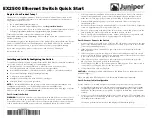
Section 2 Microwave Path Engineering Basics
TRACER 4102/4202 System Manual
20
© 2004 ADTRAN, Inc.
612804202L1-1A
Table 3 lists path loss values for various path lengths for both 2.4 GHz and 5.8 GHz systems. Values not
listed in the table can be interpolated from those listed.
5.
RECEIVER SENSITIVITY
Receiver sensitivity is a value expressed in decibels referenced to one milliwatt (dBm) that corresponds to
the minimum amount of signal power needed at the receiver to achieve a given bit error rate (BER).
Receiver sensitivity is usually a negative number of decibels and smaller receiver sensitivity (higher
quantity negative number) is better for a given BER. Several factors affect receiver sensitivity including
the data bandwidth of the wireless link, and the amount of additional signal degradation introduced in the
receiver electronics.
Receiver sensitivity of the TRACER 4102/4202 is dynamic as a function of desired bandwidth; receiver
sensitivity improves as delivered bandwidth decreases. In situations where 2xT1 connectivity is not
required, the delivered bandwidth can be decreased to 1xT1, and the receiver sensitivity will be improved
as follows:
Table 3. Path Loss for Given Path Lengths
Path Length
(miles)
Path Loss (dB)
at 2.4GHz
Path Loss (dB)
at 5.8 GHz
1
104
112
2
110
118
3
114
121
4
116
124
5
118
126
10
124
132
15
128
135
20
130
138
25
132
140
30
134
141
35
135
143
Table 4. Receiver Sensitivity for the TRACER 4102/4202
Delivered
Bandwidth
Receiver Sensitivity
Active
T1 Ports
TRACER 4102
TRACER 4202
2xT1
-96 dBm
-93 dBm
A, B
1xT1
-98 dBm
-95 dBm
A
Should an interferer be present nearby, three software selectable bandplans are provided
for frequency agility. Changing the TRACER 4102/4202 bandplan does not require
additional components, or opening of the radio. See TRACER System Option > RF
Bandplan on page 47 for additional details.
















































